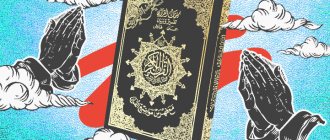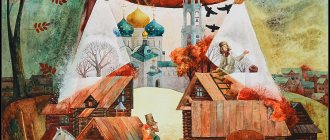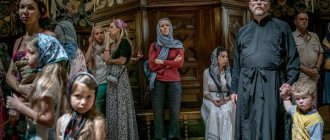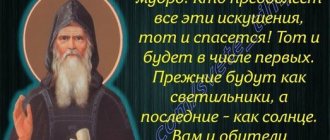| St. Dalmat. Portrait. XVIII century (?). Photo by S. M. Prokudin-Gorsky. 1912 (Library of Congress) |
Dalmat of Isetsky, Perm
(1594 - 1697), monk, reverend, founder of the Dalmatovsky Assumption Monastery Commemorated June 25, February 5 (Greek [1]) and in the Cathedral of Siberian Saints
In the world Mokrinsky Dmitry Ivanovich, born in 1594 in Berezovo (now the village of Berezovo, Khanty-Mansiysk Autonomous Okrug)
The biography of the monk is set out in “News of the Founding of the Dalmatov Monastery”
, written at the beginning of the 18th century by his son, Archimandrite Isaac (Mokrinsky). A large amount of information is contained in documents of Siberian records management of the 17th century and in the archives of the Dalmatovsky Assumption Monastery [2].
Ivan Mokrinsky, the saint’s father, served as a Cossack ataman in Siberian cities; his mother may have come from newly baptized Siberian Tatars or Ostyaks. Dmitry Mokrinsky was turned into a boyar's child. Around 1627/1628, the Mokrinsky family was transferred from Berezov to Tobolsk.
In 1628, Dmitry Mokrinsky was mentioned as the mayor of Tobolsk; in 1633, he held the position of clerk in the Vagai prison. He was married and had children. But after the death of his wife (+ 1642/1643) he left the sovereign's service and took monastic vows with the name Dalmat in the Nevyansk Epiphany Monastery.
Around 1644, seeking solitude, Dalmat left the monastery (Archimandrite Isaac (Mokrinsky) wrote that he did not want to accept the position of builder at the Epiphany Monastery offered to him) and settled in a cave on the high bank of the river. Iset at the confluence of the river. Techa, called Beloye Gorodishche
.
These lands belonged to the Tyumen yasak Tatar Iligey, who leased them to residents of the Nevyansk and Irbit settlements for fishing and animal industries. The owner of the land, under the influence of the tenants, twice tried to expel Dalmat. First, the saint “... seeing him rage like this and thinking humanly, remembering the Apostle Paul: “She was called to the Romans in Rome,” and so on, and Elder Dalmatus also fell in line with him, a Tatar, from his sister’s family: “And my mother is from the Siberian Tatars from newly baptized and born.”
And then hearing this Iligei Tatar and Abiye Presta for a short time from the murder.” The second time the saint was saved by a miracle: in the fall of 1645, Iligei, who was heading to the elder’s cave to drive him out, spent the night on the road and had a vision: the Mother of God in crimson robes with a whip in her hand commanded not only not to offend Dalmat, but also to give him the patrimony. The Tatar was seized with horror, and in the presence of his children and relatives in the spring of 1646, he transferred the possessions of the White Settlement to the monk. In 1651, the monks of the Dalmatov Monastery turned to Tsar Alexei Mikhailovich and the Tobolsk governor V.B. Sheremetev with a petition for the granting of these lands to them; the tsar’s charter dated May 17, 1659 established the boundaries of the monastic possessions.
After some time, the brethren gathered around the desert dweller and the Iset Hermitage arose; in the second half of the 1640s, a wooden chapel and cells were built in it. From the Nevyansk Monastery the monk brought with him the Dalmatian Icon of the Dormition of the Blessed Virgin Mary, which became the main shrine of the Dalmatov Monastery (lost in the 1920s). The newly founded monastery was the first Russian settlement in the river valley. Iseti. Subsequently, the Dalmatov Assumption Monastery played an important role in the education and economic development of the region; for a century it was an outpost in the defense of the eastern borders of Russia from the raids of Kalmyks, Bashkirs and Siberian Tatars.
In addition to the spiritual care of monks and laity, Dalmat devoted a lot of energy to the economic life of the monastery under construction. In the sparsely populated region, the problem of labor was acute. In search of peasants to work in the monastery estates, Dalmat traveled through the settlements of the Tobolsk and Turin districts, often came into conflict with the local secular administration, and sometimes violated the royal prohibitions regarding the admission of new peasants. Thus, in 1654, the clerk of the Kirginskaya Sloboda, M. Fefilov, submitted a petition to the Tobolsk governors that Dalmat refused to hand over the fugitive arable peasants of the Kirginskaya Sloboda who had taken refuge in the Dalmatov Monastery. The governors sent a memorial to the monastery so that “the peasants would not be accepted from the tax” [3].
| St. Dalmat Isetsky |
In September 1651, returning from another trip, Dalmat found the site of the monastery in ashes.
The chapel, cells and peasant households were burned by the army of the Siberian prince Devlet-Girey. Miraculously, the icon of the Assumption of the Blessed Virgin Mary survived the fire. And the companions gathered again, the monastery was revived. In 1662 - 1664, the monastery was again subjected to devastating attacks by Bashkir nomadic tribes and the grandchildren of the last Siberian Khan Kuchum. But after each devastation, the monastery was rebuilt again. Elder Dalmat survived difficult times of disasters and trials. Several times he was close to death, twice before his eyes the monastery was destroyed to the ground, and twice he again erected it from a pile of ashes and ruins. A church was built in honor of the Assumption with a chapel in the name of St. Demetrius of Prilutsky, cells and monastic services, the monastery was surrounded by a prison, and a church in the name of the apostle was consecrated above the holy gates in 1683. John the Theologian.
In the restored monastery, a cell was built for the saint, where he spent the rest of his life in seclusion.
Dalmat, who in his humility did not seek vain glory and power, until his death remained only a simple old monk, despite the fact that he, as the founder, organizer and leader of the monastery, rightfully belonged to the abbot of it. But although other elders officially ruled the monastery, Dalmatian authority was great, and his word was decisive. He was always a supporter of strict adherence to the canons, and no circumstances could force him to deviate from them. In the same spirit he instructed the monastery brethren. Thus, in 1664, the Tobolsk Congress House conducted an investigation into a denunciation of one of the elders against the monastery administration. Among other offenses, it was noted that the days of the angel Tsar Alexei Mikhailovich and members of his family were not celebrated in the Dalmatovsky Monastery. As Dalmat explained “in the cap behind his hand,” from the beginning of the existence of the monastery, such an order was established: if the days of the angel of the king and queen fell during Lent or fasting days, then only a prayer service was performed in the monastery for their spiritual salvation and long-term health, and the celebration took place after Bright Week. At the same time, Elder Dalmat emphasized that this was done at his command, and without his command, “the brothers, by their own will, to this day did not begin or do any spiritual or physical work.”
[4].
Thus, even under pressure, the founder of the monastery did not deviate from the charter. From the same case it is known that, on the instructions of Dalmat, armed patrols were sent “to the steppe to hear news”
about the approach of nomads. With all this, at that time the elder was already living in seclusion, so he could not even be taken to Tobolsk to examine the “sovereign’s deeds and words” in 1664.
After 1651, Isaac (Mokrinsky), the son of Dalmat, took monastic vows at the monastery, becoming the first abbot of the monastery in 1666 and archimandrite in 1702. Not only blood, but also spiritual kinship connected father and son. In the entry on the book of St. John Chrysostom “On the Priesthood” (M., 1664), blessed by the Patriarch of Moscow and All Russia Joachim to Abbot Isaac in 1682, the latter is called a disciple of Dalmatus [5]. Also, the first Kholmogory and Vazhsky Archbishop Afanasy (Lyubimov), who settled in the Iset desert in the early 1650s and lived there for more than 10 years, considered himself a disciple of Dalmat.
The Dalmatov Monastery did not immediately accept the liturgical reforms of Patriarch Nikon. The former abbot of the Nevyansk Epiphany Monastery, Eusebius (Levonov), a monk at the Dalmatian monastery, wrote in a denunciation after 1724 that Dalmatian and his son belonged to the schism [6]. There is a hypothesis that the ideologists of the Trans-Ural Old Believers appealed to Dalmat’s opinion in polemics about the essence of the Antichrist. A. T. Shashkov believes that Dalmat owns the “Message about the Antichrist and his secret kingdom”
[7].
At the beginning of the century, the library of the Dalmatovo Monastery contained 2 books that belonged to the monk:
- "Conversations on the Acts of the Apostles"
by St. John Chrysostom (K., 1624) with “Interpretation of the Apocalypse” by Andrew of Caesarea (K., 1625) (in one binding) - "Conversations on the Epistles of the Apostle Paul"
by St. John Chrysostom (K., 1623). On March 23, 1679, it was invested by the monk in the Church of St. Nicholas the Wonderworker on the monastery grounds.
The monk died on June 25, 1697 in the Dalmatovsky Monastery. While still alive, he prepared himself a coffin-deck. He was buried in the altar of the Assumption Church of the monastery.
| Chain mail and helmet of St. Dalmata. Ser.—2nd half. XVII century (?). Photo by S. M. Prokudin-Gorsky. 1912 (Library of Congress) |
In 1720, the construction of the new, three-altar Assumption Cathedral was completed.
On the site of the old Assumption Church, a cobblestone tomb was built over the burial place of Dalmata. The central place in it was occupied by a wooden tombstone, painted in 1793 by the artist I. Sokolovsky with scenes from the life of the saint. The tomb contained relics that, according to legend, belonged to Dalmatus - a helmet and chain mail donated by Iligei (currently in the Sverdlovsk Regional Museum of Local Lore), as well as a schematic robe. In 1836, the provincial secretary P. D. Ponomarev decided to build a church over Dalmat’s grave at his own expense. In 1845, the peasant M. F. Zaitsev applied to the Perm Consistory for permission to build a chapel in the city of Dalmatovo on the site “marked by the asceticism of the monk Dalmat”
. Both projects did not receive the approval of the spiritual authorities.
In 1871, near the burial of Dalmata, construction began on a church in honor of the icon of the Mother of God “Joy of All Who Sorrow.” While laying a trench under the foundation, the builders found the saint’s coffin. Eyewitnesses testified that the coffin, despite the age of burial, was in amazing preservation. But the discovery of the relics of the saint, according to the instructions of the church authorities, did not happen then. After lengthy correspondence between the rector of the monastery, Archimandrite Isaac, and the ruling and vicar bishops and the examination of the coffin and crypt by Bishop Vassian (Chudnovsky) of Yekaterinburg, it was decided to leave Dalmata’s coffin (without opening it) in the same place and change the configuration of the foundation. While the monastery was looking for a solution to how to fulfill this order, heavy rain broke out over Dalmatovo. Water filled the ditches, its level was higher than the crypt. But the monks believed that the coffin was reliably protected and, having removed the water from the ditch, did not show concern. However, during confession, two women told their confessor that they had a vision of water gushing out of Dalmata’s coffin. Impressed by what they heard, the archimandrite and the hieromonk secretly dug up the ground, dismantled the protruding part of the crypt and discovered that water had entered the coffin and left its traces - excessive dampness and a large sediment of sand and silt. As the opening of the crypt in 1994 showed, the ingress of water had a strong destructive effect on the relics of Dalmatia.
On May 8, 1881, the consecration of the temple took place, which had chapels in the name of St. Stephen of Great Perm and in the name of Saints Isaac, Dalmatus and Favst. In 1896, a stone tomb was added to the temple, located directly above the burial. From the inside, its walls were decorated with picturesque images of episodes from the life of the monk; on the northern wall there were portraits of Dalmatus and Archimandrite Isaac.
After the closure of the monastery in 1923 and the cessation of services in the Church of Sorrows in 1928, since 1933 the tomb has successively housed the wardrobe of the state farm theater, a hospital, production premises of the Start dairy engineering plant, and a laundry. The internal appearance of the tomb has changed beyond recognition. Dalmat's belongings were transferred to the local history museum. The wooden tombstone, richly decorated with paintings, ended up in a landfill. The floor was repeatedly concreted, the paintings on the walls were painted over.
In 1991, the monastery complex was returned to the Church, and the difficult work of reviving the monastery began.
Reverence
There is no documentary evidence of the canonization of St. Dalmat. However, in a report to Bishop Anthony of Perm and Verkhoturye in 1871, in one case Dalmat was simply called a monk, in the second - a reverend.
In 1864, at the request of the inhabitants of the Dalmatians, “aggravated by disasters from fires”
, an annual religious procession was established “to avert disasters” on June 24, the day of the death of Dalmatia (date inaccurate).
Since 1871, records of miracles through prayers to the saint were kept in the Dalmatovsky Monastery; about 30 such records from the 19th century have been preserved in the monastery archive. In the Urals, the monk was considered the patron saint of warriors - young people, before being sent to the army, came to the tomb of the monk, put on chain mail and a helmet.
In the 2nd half of the 19th century, in periodicals, in official documents, and in lithographic images (in particular, those published in Yekaterinburg in the 90s), Dalmatus was often called the venerable. He is commemorated in the service to all saints who have shone in the Russian land, compiled in 1918 by Bishop Afanasy (Sakharov).
In 1994, in the year of the 400th anniversary of the birth of the Monk Dalmat and the 350th anniversary of the founding of the monastery and the city named after the monastery by Dalmatov, it was decided to conduct archaeological excavations of the elder’s burial, pay due honors and rediscover the main shrine of the monastery. On August 6, 1994, the discovery of the relics of the Monk Dalmatus took place, which have since rested openly in a carved wooden shrine in the Sorrowful Church of the monastery.
In 1997, on the 300th anniversary of the repose of St. Dalmatus, a service and akathist to him were written.
In 2004, Patriarch of Moscow and All Russia Alexy II blessed to canonize the founder of the Holy Dormition Monastery, Dalmat of Isetsky, among the locally revered saints of the Kurgan diocese and include the name of the Venerable Dalmatian of Isetsky in the Cathedral of Siberian Saints with the establishment of a day of remembrance on June 25/July 8
[8].
On February 4, 2013, the Council of Bishops of the Russian Orthodox Church approved the church-wide glorification of St. Dalmatian of Isetsky.
The Monk Dalmatus is widely revered in the Urals. The Dalmatovsky Monastery keeps records of the testimonies of pilgrims and local residents about grace-filled help and healing through prayers to the Monk Dalmat.
A series of documentary films has been created about the Venerable Dalmatian of Iset, in particular, by the Creative Association “White Settlement” operating at the Dalmatovsky Monastery (films: “The Land of Siberia, an incomparable intercessor”, “Elder Dalmatian. A short biography”, “From the earthly army to the heavenly army”, “ Akathist to the Venerable Dalmatian of Iset, miracle worker").
In May 2012, a medal of the Kurgan and Shadrinsk diocese was established in honor of the Holy Venerable Dalmatian of Iset of two degrees [9]
Iconography
To date, a rich iconographic tradition of depicting St. Dalmatian of Iset has developed.
The earliest image of Dalmatus was obviously his portrait, which was on the northern wall in the saint’s tomb along with the portrait of his son Archimandrite Isaac [10].
According to G.S. Plotnikov, both images were lifetime: “...two portraits painted from life are kept;
one of the monk Dalmat, with whom is his cell robe and hood, and the other of his son Archimandrite Isaac, with whom is his staff...” [11].
Judging by the transparencies, the portraits were presumably made in the 18th century (possibly among 8 painted portraits commissioned by Archimandrite Joaquinthos in the 60-70s of the 18th century by the Tobolsk icon painter Matvey Morozov [12]), and were subsequently updated.
Dalmatian is depicted half-turned to the right, waist-deep, dressed in a hood and mantle, his right hand with a rosary at his chest, a high staff in his left, and a lengthy text with his biography below. The individual features of the old man’s face are conveyed conventionally: large eyes, a clear line of eyebrows, a thin straight nose, sunken cheeks, several wrinkles on the forehead above the bridge of the nose, slightly curly gray hair to the shoulders, a long, thick beard. The portrait was reproduced from the chest up in a lithograph from the late 19th century. (a photograph has been preserved from the archives of the Dalmatovsky Monastery [13]).
In the 1740s, a painted wooden sculpture of Dalmata was created (not preserved), which stood inside the cave in the form of a niche in the northern wall of the refectory of the lower Nativity Church of the Assumption Cathedral of the monastery (“... a stove was laid out, there were doors in it, opposite them, in the stove there was a pattern in human size, carved, from the beginning of the local monastery of the monk Dalmata, painted with decent colors"
[14]). In the 1770s, this three-dimensional composition became the center of a pictorial cycle illustrating the history of the Dalmatian Monastery: above the niche were painted images of the stone Assumption Cathedral, on the sides of which are the figures of Dalmatian and Archimandrite Isaac, at the top is the revered icon of the Dormition of the Blessed Virgin Mary, supported by two angels , as well as poems on this topic.
In 1793, the icon painter of Little Russian origin Ivan Sokolovsky (arrived at the monastery in 1777) painted the tomb over the grave of Dalmat. 3 side panels of the tombstone depicted scenes from the life of the saint, accompanied by detailed inscriptions on the scrolls: Tatar Iligey, planning to kill Dalmat, is heading from Tyumen to White Settlement; the appearance of the Mother of God to Eligea in a dream vision “with an attractive rod”; Iligei and his relatives confess their evil intentions to Dalmatus and cede their patrimony to him; on the 4th side there was a poetic chronicle of the monastery, outlining the history of the monastery during the time of Dalmatian and his son Archimandrite Isaac. Scenes from the Life of Dalmatia were presented in the interior painting of a stone tomb (1896) over the grave of the saint at the church in honor of the icon of the Mother of God “Joy of All Who Sorrow.”
Dalmatus is named as a monk on a tone lithograph published in Yekaterinburg in the 1890s (censor's permission in 1890 from Archpriest Simeon Vishnyakov, copies in private collections). The image of the saint with a halo from the late 19th - early centuries dates back to the original portrait, apparently using the chromolithography technique (a photograph from the archives of the Dalmatov Monastery has been preserved), as well as several modern images: an icon from the 1990s - a gift to the Dalmatov Monastery from Abbot Tikhon (Zatekin) when he was his abbot of the Verkhoturye St. Nicholas Monastery (the Saint is presented against the background of monastery buildings, repeating the appearance of the monastery in the chromolithograph by E. I. Fesenko of 1902; a similar image is in the Verkhoturye Monastery); 1994 icon of the monastery resident, icon painter, Hieromonk David (Ernazarov) in a circle (placed in the front part of the shrine); icon of 1997 by O. Voronova Resurrection Church in Shadrinsk.
For the glorification of Dalmatia in 1994, in the Moscow workshop of I. Isakov, an icon of the saint was painted, depicted frontally, waist-deep. To celebrate the 300th anniversary of his repose in 1997, Odessa icon painter I. N. Stoyanov created an image for the church of St. Nicholas the Wonderworker in the village. Borovsky (currently in the monastery in the name of Dalmat, Katai district, Kurgan region) - the monk is presented in a hood, a mantle, with a name-giving right hand and a staff in his left hand.
On the half-length icon of 2000 by A. Markov (the Cathedral of the Blessed Prince Alexander Nevsky in Kurgan) Dalmatian is dressed in a schema with a doll on his head, in his hands is a model of the monastery, at the top is the image of the Mother of God “The Sign”; A particle of the saint’s relics is embedded in the icon. A half-length rectilinear image of Dalmatus with a particle of relics (2001, icon painter P. Rublev) is located above the saint’s shrine.
Biography[ | ]
Dmitry Mokrinsky was born in 1594 in the family of the Cossack ataman Ivan Mokrinsky in the Berezovsky fort of the Berezovsky district of the Tobolsk category (now the urban-type settlement of Berezovo - the administrative center of the Berezovsky district of the Khanty-Mansiysk Autonomous Okrug - Ugra [2]). His mother, presumably, came from newly baptized Siberian Tatars of the Tyumen Murza Iligei family [3] or Ostyaks. The family had three sons: Dmitry, Savvaty (died in the 1643-44 salary year) and Fedor[4].
From documents of Siberian records management it is known that Dmitry was listed as a child of the boyars and around 1627-1628 he and his family were transferred from Berezov to Tobolsk. In documents of 1628 he is mentioned as the mayor of Tobolsk, and in 1633 - as a clerk in the Vagai prison[5]. During the period of Dmitry's service as Tobolsk mayor, in the lodge where he spent the night, on December 9, 1628, a fire occurred in which the city seal, voivodeship affairs and a large sum of money were burned [6]. An investigation was carried out on suspicion of deliberate arson, as a result of which all charges against Dmitry were dropped. In 1633, he detained two fugitive convicts from Tobolsk, taken prisoner during the Smolensk War. Due to a lack of income (the sovereign's salary was a bread salary of 11.5 quarters) to support his family (Dmitry had five children), he started ploughing, and, according to his son Isaac, was “ not very rich, but while living he brought great poverty , building his house in abundance, according to his faith he carried the needs of the diligent church
»[6].
In 1642 (1643) Dmitry left the service, his wife, children[7]:4 and took monastic vows with the name Dalmat in the Nevyansk Spaso-Epiphany Monastery. Probably, the choice of this monastery for tonsure was due to the fact that his brother Savvaty lived in the Nevyansk settlement[6]. Around 1644, Dalmat, in search of solitude, left the monastery, where he was offered the position of a builder, and began to live as a hermit in a cave at the confluence of the Techa River and the Iset River, called the White Settlement. In the same year, he erected a wooden chapel. This land was the property of the Tatar Iligey, who leased his lands for fishing to the Irbits and Nevyansts Korolev and Shipitsyn[8], and under the influence of the tenant he twice tried to drive Dalmat out of his cave. According to the life of the Monk Dalmat, in 1645, when Iligei went to the cave to drive Dalmat out, the Mother of God appeared to him and ordered him to give this land to the hermit. In the spring of 1646, Iligei transferred the White Settlement into the ownership of the Monk Dalmat (later in 1659, by royal charter, these lands were assigned to the monastery founded by Dalmat)[5].
Dalmatian icon of the Dormition of the Blessed Virgin Mary
Soon a group of followers formed around Dalmatia, the Iset Hermitage was created, which became the first Russian settlement in the valley of the Iset River[5]. Dalmat's first associate was Elder Ivan from Nizhny Novgorod. Since 1649, Timofey Nevezhin, the founder of the city of Kurgan, lived in the Dalmata monastery for his contribution, who performed all monastic work without a monetary or grain salary[9]. With the blessing of Tobolsk Archbishop Gerasim (Kremlev), a wooden chapel was built in the monastery. The main shrine of the monastery was the icon of the Dormition of the Blessed Virgin Mary, brought by Dalmat from the Nevyansk Monastery. In September 1651, the desert was burned by the army of the Siberian prince Devlet-Girey[10]. Some of the monks were killed, the rest were taken captive[7]:5. The Monk Dalmatus was absent during the raid on the deserts and, coming to the ashes, found an intact icon of the Dormition of the Theotokos[11]. After these events, companions came to Dalmatia again, and the monastery was restored. In the early 1650s, Afanasy (Lyubimov), the future first archbishop of Kholmogory and Vazh, came to Dalmat, became his student, and lived in the desert for more than 10 years.[5] In the Iset Hermitage, with the blessing of Archbishop Simeon of Tobolsk, the Church of the Assumption of the Blessed Virgin Mary with the chapel of Demetrius of Prilutsky and a cell was built, and the monastery itself was surrounded by a prison.
In 1651, the elders petitioned Tsar Alexei Mikhailovich and Tobolsk governor Vasily Borisovich Sheremetyev with a request to grant them these lands. By royal charter of May 17, 1659, the hermitage was approved as a monastery, its protection was entrusted to the Tobolsk governor[7]:9. The first abbot of the monastery was the son of the Monk Dalmat Isaac, who took monastic vows at his father’s monastery after 1651. In the monastery, a separate cell was built for Dalmat, in which he was in seclusion (in the entryway, to remind him of his hour of death, there was a coffin prepared by Dalmat for himself). Despite this, in a letter to Tobolsk dated 1664, he reported that without his instructions, “ the brethren, by their own will, to this day have not begun or done any spiritual or physical work.”
"[12].
Dalmat also wrote that he sent patrols to the steppe to inform about the approach of nomads. In 1662-1664, the monastery was repeatedly subjected to raids by nomadic tribes, which ravaged it (for example, about the raid of Sarah Mergen’s detachment in 1662, archival documents report that the monastery “ was not left by the barbarians even in ruins, but was burned to the ground
” [6]) . During this period, Dalmatus was close to death several times, twice his monastery was destroyed to the ground and twice he restored it from ruins[13]:181.
The Dalmatom monastery maintained a very strict monastic rule. So, in 1664, the Tobolsk Congress House considered a denunciation against the leaders of the monastery, which stated that it did not celebrate the days of the angel Tsar Alexei Mikhailovich and members of his family [13]: 182. In his own explanations written by Dalmat, he reports that in his monastery the royal name days, which fall on the days of Great Lent, are celebrated only by performing a prayer service, and the celebration takes place after Bright Week. To spread Orthodoxy in the Trans-Urals, Dalmat, together with his son Isaac, in 1684 founded the Vvedensky Convent for women near the Assumption Monastery, in which 27 sisters lived[7]:11.
After Patriarch Nikon carried out the liturgical reform, Dalmat did not immediately accept the corrections of the liturgy[5]. Due to the connection of the Dalmatian Monastery with the Old Believers, Dalmatian’s son Isaac was removed from the abbess around 1668 (all bans from him were lifted only in 1685 under the condition that he “not speak with schismatics”). The former abbot of the Nevyansk Epiphany Monastery, Eusebius (Levonov), who took monastic vows in the Dalmatian Monastery, wrote in his denunciation about the belonging of the Monk Dalmat and his son to the Old Believers: “he was an evil schismatic and did not partake of the holy mysteries, so he withdrew his soul from the saint without repentance church, pervert”[14]. According to one hypothesis, the Trans-Ural Old Believers, in their disputes about the essence of the Antichrist, appealed to the opinion of Dalmat (Reverend Dalmat is credited with the authorship of the “Message about the Antichrist and his secret kingdom” addressed to the Old Believers)[15]. V.N. Tatishchev also writes about Dalmatian membership in the Old Believers, reporting that he went into schism even before his monastic tonsure, lived in the desert for 10 years and was converted to Orthodoxy by the Tobolsk bishop[16]. This message is considered to be based on unreliable rumors[17].
Cancer of St. Dalmatian (S. M. Prokudin-Gorsky, 1912)
The Monk Dalmat died on June 25 (July 5), 1697 at the age of 103 [13]:183. The monastic chronicle reports the following about this[6]:
...in perfect years, ripe in virtues, like full wheat for the heavenly granary, he reposed peacefully on the 24th day [ sic
] June 1697. Hegumen Isaac, without a doubt, not without tears, having hidden his mortal remains in this tomb, interred him at the altar of the wooden Assumption Church, in memory that Elder Dalmat was the culprit and the first founder of this temple.
Prayers
Troparion, tone 4
, approved by the Holy Synod on July 29, 2017 (in the Service of the Dalmatovsky Assumption Monastery - “Introparion” [15])
You have fought a good fight, / by fasting, vigil and prayer, you have acquired the love of Christ, / by the wonderful intercession of God to the Mother, / you have counted the threats of the infidels as nothing, / like a light on you Thou shalt shine forth in Heaven,/ like our Father Dalmatia, // pray to Christ God save our souls.
Troparion, tone 2
(from the Service of the Dalmatovsky Assumption Monastery [15])
Wonderful and glorious servant of Christ,/ running to glory and honors of all kinds,/ you settled in the desert of Isetia,/ building up your abode in prayers, like the walls of Jerusalem,/ intercession You miraculously found the Queen of Heaven, / by the fear of God, casting your former enemy at your feet // and again raise up our hearts, defiled by apostasy.
Kontakion, tone 4
, approved by the Holy Synod on July 29, 2017 (in the Service of the Dalmatovsky Assumption Monastery - “In Kontakion” [15])
From your youth you loved Christ, / you despised vain and worldly wisdom, / you bravely settled in the desert, / you conquered all the adversities of the enemy, / and the good warrior of Christ appeared. and us, who honor you with faith, // Blessed Dalmatia.
Kontakion, tone 2
(from the Service of the Dalmatovsky Assumption Monastery [15])
With prayers and faith, he fenced off his monastery, / greatly transformed the land of Isetskaya, / sealed the honorable old age with his blessed dormition, / did not leave us with the appearance of your relics, / our reverend Father Dalmatia, // and now appear and intercede for those who honor your holy memory.
Current state
At the moment the monastery is active. There are brethren here again, the number of parishioners is growing every day. However, the building itself is in terrible condition, not to mention the lost relics. Restoration and restoration work is underway.
The architecture of the old days was practically lost. The foundations are destroyed due to weathering and inferior brickwork, which, by the way, was often broken. The roofs are constantly leaking. One of the towers slowly begins to fall due to dampness and destruction of the base.
Literature
- Lobby books of the Dalmatovsky Assumption Monastery (last quarter of the 17th - early 18th centuries)_ / Compiled by: I. L. Mankova. Sverdlovsk, 1992. P. 184-186 [“News about the founding of the Dalmatovsky Monastery”];
- The first century of Siberian cities, XVII century.
Novosibirsk, 1996. pp. 52-53. (History of Siberia. Primary sources; Issue 7); - “Ordered to be in the sovereign service in Siberia”: Documents of the 17th century.
on the appointments and activities of clerks of the Ural settlements / Publ. prepared I. L. Mankova // IA. 2005. No. 4. P. 180-195. - Plotnikov G.S. Description of the male Dalmatovsky Assumption Monastery and the female Vvedensky Monastery that was attached to it.
Ekaterinburg, 1906; - Mankova I. L., Shashkov A. T. Isaac (Mokrinsky)
// SKKDR. Vol. 3. Part 2. pp. 113-116; - Korostelev V. Circumstances of the transfer of the relics of St.
Dalmata in 1871 // Rus. language, literature and culture: Materials of the region. scientific-practical Conf., 23-24 Nov. 1999 Shadrinsk, 2000. P. 58-60; - Mankova I. L. Tobolsk service people Mokrinsky
// Problems of Russian history. books, culture and societies. consciousness. Novosibirsk, 2000. pp. 323-329; - Pashkov A.A. Holy Dormition Dalmatovo Monastery.
Shadrinsk, 2000.
Famous students of the monastery
Dalmatovo Monastery has a long history. Over so many years, a huge number of famous people have visited the walls of the monastery. However, there are those who became famous after being raised in this monastery:
- Archimandrite Antonin - head of the Russian spiritual mission in Jerusalem;
- Inventor A. S. Popov;
- Founder of the Imperial Siberian University V.M. Florinsky.
These people brought a lot to the life of the Russian state. So every schoolchild knows Alexander Stepanovich Popov.






